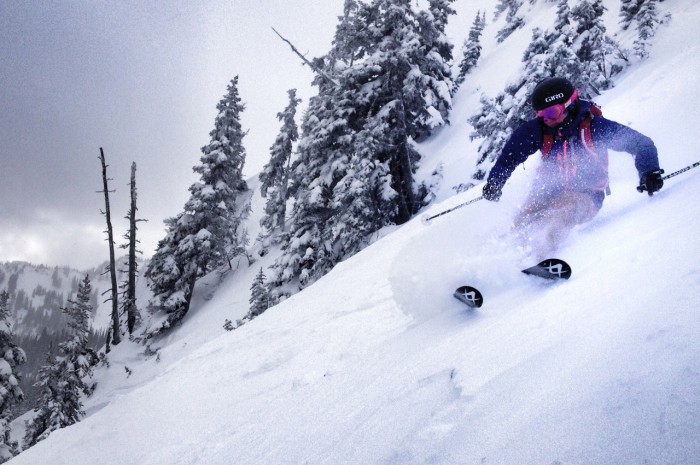Skills: Ingrid Backstrom Works Those Angles

Next time you’re turning down a moderate slope and there are no major obstacles in front of you, look down at your legs. Try to observe them during the turn and in between turns and see where they’re at. Glance at your skis also, and then try to think back to 8th grade geometry class: are both the skis making the same angle with the slope during all parts of the turn?
If so, congratulations are in order—first, that you are working parallel angles in the turn and, second, that you can ski and think math at the same time. Highly impressive.
If not—and/or if you are noticing some A-frame, knock-kneed action going on with your legs, don’t despair. Or go ahead and despair if you really hate math. But it’s worth it, I promise. Dusting off a little bit of that old geometry knowledge will go a long ways towards improving your ski style and efficiency. Here’s how:
1) Standing flat on your skis on a flat spot, with equal weight on both feet and feet hip-width apart, lean forward and press your shins against your boots, bending forward at the waist but not rounding your back. Look down to see that your ankles, knees, and hips as well as the bases of your skis are all parallel to each other. From this position, rock side to side, staying forward, and looking down to keep the angles all parallel. If your knees won’t stay parallel, act like you are pressing out with the side of the foot you are leaning towards, as if you were rolling over on that ankle. Engage your butt to help stabilize and use that strength to get parallel.
2) Practice until you can do that easily and keep parallel legs. This is important because whether you’re carving on the edges of your skis or sliding on the bases, when the skis aren’t parallel you are basically dragging one ski—which is slowing you down, creating a lot more work for yourself, probably looking and feeling slightly awkward, and maybe even causing you to catch an edge and tumble.
3) Next, take it to a slope. Do the same thing as before, but add some gravity and forward motion. When turning to the right, if your knees are A-framing, pay attention to the right ankle and butt, and really push that right ankle ball out and engage your hip and butt so you’re not collapsing into the backseat.
4) Another important angle is the tilt of your chin. It sounds silly, but often people tilt their chins down and look right in front of them. If you lift your head and tilt your chin slightly forward and down the hill, it will help you look ahead a few turns and ski smoother and faster.
5) Now, put it into practice all the time! Pay attention to your angles in all conditions, even when you’re just gliding along a flattish cat track. Look down and roll those ankles slightly out to ensure that your bases are completely flat. The more you use those muscles’ memory and keep them working for parallel angles, the more it will just come naturally. Your edges will be used like they are supposed to—for slicing, carving, smooth-snow-spreading, and total shredding.
Kamagra oral jelly Online something to buy the most convenient way. He doesn’t demand from you any actions except how to visit the website. And in separate with goods necessary to you to put the end. To specify your address and to wait for the supplier to whom you will give money.

LET'S GET SOCIAL